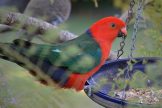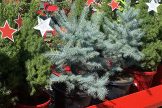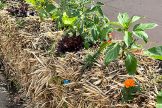
Living with possums isn’t always easy, but there are a few things we can all do to live in harmony with possums in our shared urban spaces. Let’s face it… we are never going to get rid of them altogether, and why should we? They were here long before we were, and it is our destruction of their habitat that has forced them into our houses and our gardens. So, what steps can we take to make sure we can all get along together?
“They ate all my fruit!”
“All that banging about and carrying on – I’ll never get a good nights sleep.”
“The little buggers stripped my roses!”
“Who ate all my seedlings?”
Possums eating your plants?
Even the most patient and wildlife friendly gardeners tear their hair out over this one, but there are solutions to stop your precious plants being gobbled by hungry possums. Possum repellents work by two methods, taste and smell. Research conducted has shown that smell deterrents are somewhat more effective than taste, but also suggests that a starving possum will eat just about anything. Here is a list of some tried and true methods of deterring possums.
• Net affected plants with shade cloth or white bird netting at night time. Quick, cheap, and effective. This is the best way to protect young plants and seedlings from possum attack. You can also supplement this with a hanging cat scare face or two. These scare faces look like cats and have reflective eyes, pretty scary if you are a possum!
• Making a deterrant from dog hair or cat fur can work really well. Possums are scared of both and will avoid the smell.
• Sprinkling blood and bone fertiliser around the base of ornamental plants and fruit trees can act as a significant possum deterrent. They hate the smell, and will be less inclined to munch on treated plants.
• A home made garlic spray of 2 tablespoons of crushed garlic in one litre of hot water, left to stand overnight, strained and sprayed onto foliage, fruits and tasty growing tips is an old favourite, and it seems to work. Subsequently, try chillies or Indonesian fish sauce. Just remember to wash your produce before eating.
• A spray made from Quassia chips (chips of bark from a South American tree). Add 100 g chips to 2 litres water and heat for one hour before straining. Add one tablespoon detergent. Dilute at rate of 1 part of solution to four parts water and apply as a spray. Quassia chips are available at many nurseries, and are pretty affective, forming the base ingredient of many commercially available possum repellents (e.g.: Poss-Off).
• You can also try a tea-based deterrent. Boil two litres of water; add 4 heaped teaspoons of Lapsang Souchong tea and leave to cool. Strain of liquid and apply from a plastic spray bottle directly onto affected plants. Reapply every two weeks and always after rain. Make a fresh brew every time.
• Undiluted Tabasco sauce can be used on affected plants, a sure solution unless your possum likes it hot!
• A watered down solution of a little detergent and some English mustard sprayed directly onto the foliage and fruits of tasty plants.
It should be remembered that no one solution is guaranteed, and reapplication of sprays should be a regular and ongoing activity. It is recommended that most sprays be re-applied every two to three weeks as well as after rain. Try using these repellent sprays along “possum highways” as well (e.g.: tops of fences, well used tree branches). As possums are creatures of habit, any disruption to their regular routine can be really upsetting and will often result in the possum moving elsewhere.
Persistence is the key. A habit is not broken in a day, so keep up the spraying, re-apply, and over time the undesirable behaviour should slow or stop. Good luck!
Possums in the roof?
There is one reason that possums will shift in to our roof spaces… lack of hollows in their habitat. Common Brushtail possums utilise tree hollows for resting and nesting during the day, and are pretty happy to do so. But, the removal of remnant trees in urban areas has severely diminished the number of hollows available, and thus, we end up sharing our houses with them. So, what can we do to help them… and us? If you currently have possums in the roof, here are some tips that should encourage them back into the wild:
• Make or buy a suitable nest box for the Common Brushtail possum, and install it in your garden to act as an alternate den site for our furry friends. We have a range of nest boxes on display here at BAAG, talk to one of our nursery staff when you are in next.
• Locate the nest the possum has built in your roof, remove it (when the possum is out and foraging) and place this inside the nest box. This will encourage the possum to move to its new location.
• Place a piece of fruit inside the nest box. Apple or bananas seem to work best. This will entice the possum to investigate the nest box, and hopefully decide to stay. It should be stressed that feeding of possums is not recommended (except as a one off during relocation).
• Block off access to your roof. This can be done by lopping any overhanging branches, and placing collars around the trunks of trees that possums utilise to access the roof. Collars can be made from a number of products, but 60cm wide sheet iron seems to work pretty well.
• Place camphor blocks OR mothballs in the roof space, particularly around the area where the nest site was. DON’T place both! Possums really dislike these smells, and will be reluctant to return.
• If possible, pop a light up in the roof space, and leave it there for a few days (on of course!). The combination of alternate nesting site, bad smells and light should be sufficient to discourage them.
• Once you are satisfied that the possum has left the building, block any known entrance points. Wiping around the entrance points with household bleach will remove possum scent, and make re-entry pretty unappealing.





